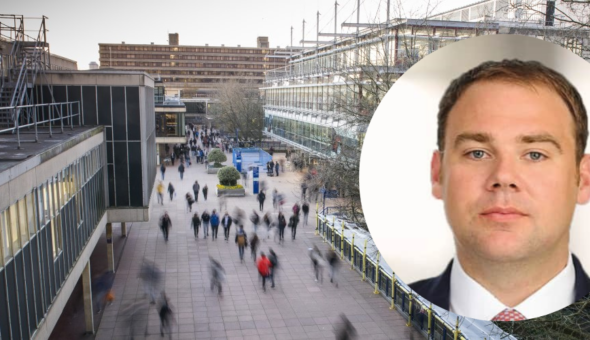Graduating in 1974 with a degree in Horticulture, Stephen Scrivens' time at Bath was a springboard to a career in construction and sustainability that has spanned the globe. He tells us about the early days of computers, creating his own roles and defying gravity on campus...
“When I first visited the University, the only structures on the site were the South Building (now 4 South) and a very tall stainless steel chimney at the north end of what came to be Norwood. When I left in 1974, the central concourse was complete and the small hostels on the north side of the site were finished and in use.
“I never lived on campus. Instead I was billeted in a small hotel near the Assembly Rooms for the first year and after that I shared a small terraced house with three other students. As I had worked before university, I owned a battered Series Two Land Rover. Every day on my way to Claverton Down, I would stop at the bottom of Bathwick Hill and load up with waiting students. As I recall my largest load was 15 – five in the front, with the rest stacked in the back!
“My placements during my degree were varied. They included six months growing nursery stock in Pennsylvania, US. At the end of my period there, I bought a car, collected my girlfriend from an airport in New York and drove in a figure of eight across the US. 13,000 miles in five-and-a-half weeks – something that I would never have done without my industrial placement!
“My advice to any student who works abroad is to explore the host country as if you’re never going back. The world is a big place and when your career takes over your life you will never have the time to collect these sort of experiences. Also, sleeping in a car also loses its appeal as you get older.
Modernising technology
“Computer technology has changed dramatically over the last 50 years. In 1970, the computer suite was located in the building to the west of the library. Through a large window you could watch technicians wandering around in a room with vertical freezer-type boxes with spools of tape whirring round on the front.
“We had to write our own programmes in Fortran. We transferred our efforts onto long cards by punching holes in them on chunky machines that resembled a typewriter. The cards were held in a bundle with an elastic band and placed in a tray. Overnight the cards were fed into the computer and the next day we collected them wrapped in a printout.
"The first few attempts were always a failure – a full stop instead of a colon would stop everything. The introduction of computer packages was seen as an amazing innovation – manna from heaven! By the late '70s there were remote terminals scattered across the University, but if you were uploading large amounts of experimental data you had to work through the night as the system was invariably overloaded during the day.
“For one RAG Week stunt I abseiled down the south side of Norwood half a dozen times. No fancy equipment – just a strop wrapped round the legs, a carabiner to attach the strop to the rope and a pair of thick gloves. The descent wasn’t much slower than gravity! I don’t remember health and safety being given much consideration.
“After Bath I went to the University of Sheffield to study Landscape Architecture. That was a cultural shock! The range of sports was very restricted and traditional, and concerts were brought to a sudden conclusion at 10.30pm when the lights were turned on. At Bath, the main group seldom came on before 1am and at 3am there would be a film followed by breakfast for those who were still standing. I often finished the night sitting next to a runway with my parachute on the grass beside me.
“After finishing university, I worked as a lecturer in construction at a horticultural college so that I could do an external PhD. I wrote an article in The Architects’ Journal some 45 pages long that had a print run of 50,000, so I was the flavour of the month and was asked to undertake a number of major landscape projects as a result. At that point my PhD was shelved… One day I will find out what was happening when I persuaded foliage to change colour from green to red or blue!
Creating a niche
“One Management lecturer at Bath had stressed the importance of ‘duty of care’ in business. In the early ‘80s I attended a project meeting at which the client asked me if I had all the information that I needed. I explained that I did not hold all the relevant drawings. A week later, two very large boxes were delivered to my office containing every drawing for the project.
“I walked round these boxes for a couple of days and finally convinced myself that I had to examine them. I then became aware of number of discrepancies so I wrote a letter, sent it off and invoiced my time. Nothing was said but the invoice was paid. I continued in this manner for two decades, eventually being commissioned just to check drawings for a number of major projects.
“I knew enough about architecture, engineering, material science, hydrology and services to identify points of conflict, so I essentially created a job for myself. It turns out that blending applied science and technology with a large dose of business management can be very useful to some big organisations.
“I imported the first 12m tall trees into Europe from the US in 1982 (when it was supposed to be impossible) and completed the first planted atrium in 1983. In 1988 I was asked to masterplan my first business park, Arlington Business Park in Theale, which received the Financial Times Business Park of the Year award in 1992.
"Over the course of my career I worked on more atriums than anyone else in Europe, and was heavily involved in the technical design of their mechanical and electrical systems.
“I’ve worked on over 80 major building projects – including the headquarters for 16 companies including Sony, Canon, Robert Fleming, Anglo American and HSBC in Hong Kong. I also designed the public areas in 14 shopping malls.
“Two years ago I returned from a five-year stay in New Zealand. I went there to see if it is possible to build an off-grid home – ie a truly sustainable building. It was a very expensive experiment for me personally but it satisfied an obsession that had been with me since my time at Bath.
"I can confirm that it is just possible, but you have to pick the right location and to change your lifestyle. During the course of this project I also worked out how to strip the energy from domestic waste and to fix carbon dioxide without the need for a large industrial plant – but that is a story for another day…!”
Respond



